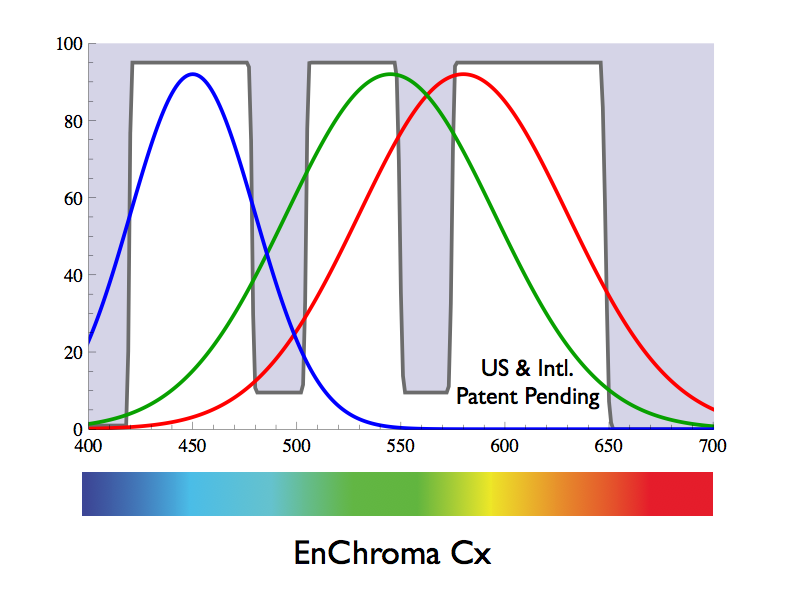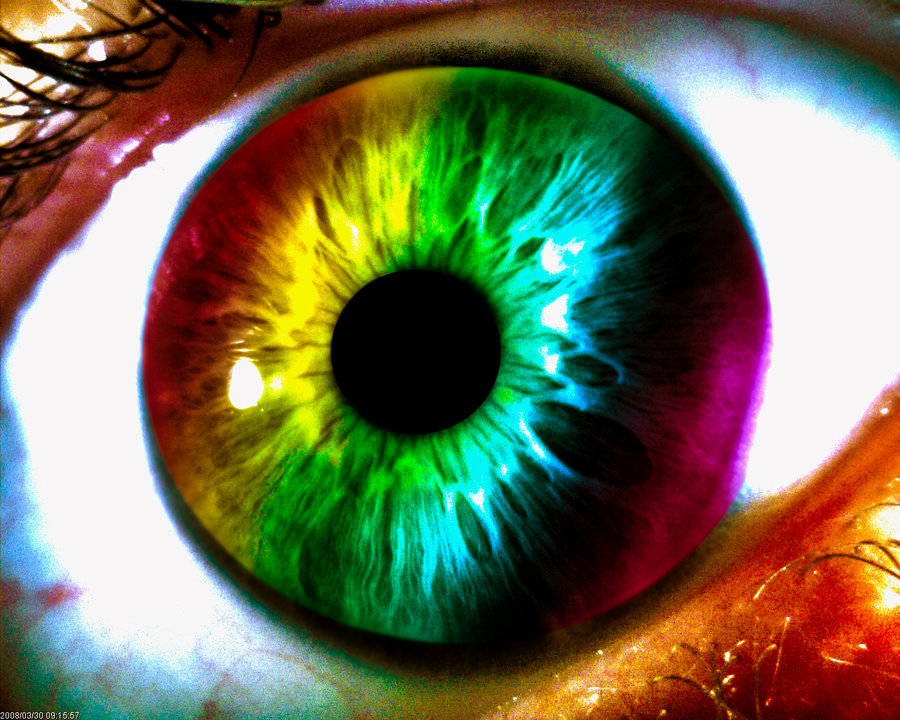In this issue of The Differential, we have the opportunity to explore two meanings of the term “hacking” as they pertain to the medical field. While my colleague Laeth George alerts us to the more sinister type of hacking (a.k.a. “medjacking”) that occurs through remote attacks on medical devices, I have the opportunity to discuss a friendlier sort of hacking: the application of easy, innovative solutions to seemingly complex problems. EnChroma glasses are a particularly interesting example where a piece of protective gear from the physics realm was re-purposed to help the color blind.
One fine day in graduate school, my officemate turned to me to ask, “Hey . . . was that guy wearing hot pink shoes?” “No, no, those were grey.” “Oh, ok! That’s just what hot pink looks like to me.” A fair portion of my understanding of color blindness came from sharing an office with this student for two years—as another example, his favorite “color” was lime green and orange because they both looked exactly the same to him. At first, it did not seem as if his condition greatly affected his quality of life, aside from a few mismatched clothing incidents. However, I became aware of how colors that have seemingly stark contrasts in academic presentations, advertising, and other media can actually be quite difficult for the color blind to discern. Depending on the country and/or state, color blindness can also limit someone’s career prospects, especially if this individual had ever considered becoming a pilot, police officer, firefighter, electrician, artist, or cell biologist.
Pathophysiology of Color Blindness
While the term “color blindness” is often heard, it actually includes several different but related conditions. The eye recognizes colors through the stimulation of retinal cone cells, which include those that recognize long (“red” or prot-), medium (“green” or deuter-), and short (“blue” or trit-) wavelengths of light. Trichromatic vision requires the normal functioning of all three of these receptors. The complete absence of one receptor will result in dichromatic vision, with protanopia and deuteranopia each being a common X-linked recessive trait that appears in 1% of males. Even more commonly, all three receptors will be present, but one will be defective, producing a greater overlap in excitation light wavelengths between cones (i.e., the same wavelengths will stimulate two cones instead of one, reducing someone’s ability to tell one color from another). Protanomaly (“protan”) leads to poor red-green discrimination, and deuteranomaly (“deutan”) is the most common form of color blindness, resulting in a mild deficiency in red-green discrimination in 5-6% of males. In more than 80% of cases of red-green color blindness, the amount of spectral overlap is less than 100%, which suggests that the eye can still distinguish between red and green at the extremes of the recognized spectra.
A Fortunate Accident
In 2005, Don McPherson, PhD, was a glass scientist based in Berkeley, CA, who specialized in making laser safety eyewear for surgeons. The glasses would absorb the specific wavelengths of light emitted by the laser while also enhancing the color saturation of blood and tissue. Because he enjoyed the glasses so much, McPherson would often wear them in place of sunglasses, and one day, he let his friend borrow them for a game of frisbee. This color-blind friend surprisingly found that he could see the orange color of traffic cones for the very first time. With this discovery, McPherson started clinical trials for his new product and founded EnChroma Labs with two other partners.
McPherson’s glasses fortuitously blocked the same wavelengths of light that comprise part of the spectral overlap that occurs in protan and deutan deficiencies (those with a completely non-functioning cone would unfortunately not be able to benefit from EnChroma). Through the development and application of color-vision computer models, EnChroma adjusted the filters of their glasses to provide the optimal level of color vision for their color-blind clients (Figure). The reactions to these glasses have been largely positive; a few months ago, one particular YouTube video went viral, showing a father with color blindness who was overwhelmed when he experienced trichromatic vision. The Atlantic reported a 53-year-old ex-marine breaking down in tears when he saw the red of a brick building for the first time, and similar emotional accounts have cropped up all across the internet.
Simple Hacks for Complex Tasks
Without resorting to high-tech wearables or Google Glass apps, EnChroma provides a relatively straightforward method to assist the color blind: simply cut out the wavelengths that muddle their color recognition. This form of hacking has been gaining popularity in the medical field, with institutions even holding competitions for the best hacks to tackle issues in global health, primary care, telemedicine, and wearables (see MIT Hacking Medicine and Baylor’s Global Health Hackathon). In the first issue of The Differential, Andrew Kantzos explained how he could use 3D printing to generate simple assistive devices for patients with disabilities. While it is certainly beneficial for the medical field to continue research in complex disease mechanisms and increasingly advanced therapies, perhaps it would be just as prudent to extrapolate from the possible uses of the tools that we already have at hand.
- George L. Medjacking: Hacking Medical Devices. The Differential. September 8, 2015. http://www.thedifferentialdx.com/medjacking-hacking-medical-devices. Accessed September 8, 2015
- Purves D, Augustine GJ, Fitzpatrick D, et al., editors. Neuroscience. 2nd edition. Sunderland, MA: Sinauer Associates; 2001.
- Technology | Enchroma. http://enchroma.com/technology. Accessed September 1, 2015
- Schmeder AW, McPherson DM, inventors. EnChroma, Inc., assignee. Multi-Band Color Vision Filters and Method by LP-Optimization. US patent application 14/014991. August 30, 2013
- Zhou L. A Scientist Accidentally Developed Sunglasses That Could Correct Color Blindness. Smithsonian. March 3, 2015. http://www.smithsonianmag.com/innovation/scientist-accidentally-developed-sunglasses-that-could-correct-color-blindnes. Accessed September 1, 2015
- Colorblind guy experiences true color for the first time with EnChroma glassses. https://www.youtube.com/watch?v=fTpCTDwjHZQ. Accessed September 1, 2015
- Morrison O. A Cure for Colorblindness. The Atlantic. March 1, 2015. http://www.theatlantic.com/technology/archive/2015/03/a-cure-for-colorblindess/386450. Accessed September 1, 2015
- Martin C. EnChroma’s Accidental Spectacles Find Niche Among the Colorblind. The New York Times. August 15, 2015. http://www.nytimes.com/2015/08/16/business/enchromas-accidental-spectacles-find-niche-among-the-colorblind.htm. Accessed September 4, 2015
- MIT Hacking Medicine. http://hackingmedicine.mit.edu. Accessed September 1, 2015
Global Health Hackathon. https://www.bcm.edu/global-initiatives/innovation-center/hack-a-thon. Accessed September 1, 2015 - Kantzos A. 3D Printing Assistive Living Devices. The Differential. July 4, 2015. http://www.thedifferentialdx.com/3d-printing-assistive-living-devices. Accessed September 1, 2015
Sophie Sun is a medical student at The University of Arizona College of Medicine – Phoenix, class of 2018. She completed her undergraduate degree at UC Berkeley and earned a PhD in chemical biology from The Scripps Research Institute, where she focused on unnatural amino acid incorporation and antibody engineering. Some of her current academic interests include student-run free clinics, vaccine compliance, and accountability in research. However, she might sound more excited when talking to you about classic American cinema, urban compost collection, and French dessert recipes. She is currently pursuing a career as a Med-Peds physician.

